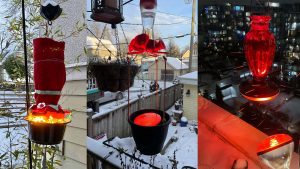B.C. hummingbirds need human help to survive cold snap say experts
Posted December 29, 2021 12:14 pm.
Last Updated January 3, 2022 10:18 am.
With more snow and cold on the way for the Lower Mainland, local hummingbirds are feeling the freeze and may need human help to get through the wintry weather, according to avian experts.
While most species of hummingbirds migrate south for the winter in search of food, many Anna’s Hummingbirds stay on the Pacific coast year-round. UBC Zoology professor Doug Altshuler attributes this not only to changing climates, but also, in large part, because humans – and the flowers we plant – keep a food source around for the birds.
He says the birds do have some evolutionary tricks, including fluffing their feathers to insulate themselves, and going into a sleep state at night called torpor, which is a very deep sleep that reduces their body temperature and metabolism to use up less energy.
Related articles:
-
Heavy snow on the way as Metro Vancouver, Fraser Valley warm up
-
Dangerous cold continues in B.C. as several areas break temperatures records
They can also feed on insects and, in some cases, sap, but with most flowers and bugs gone, and because they have the highest metabolism of any heat-generating animal, human-made feeders have become a major winter food source for them.
“Because of all of this food we’ve provided, both through our ornamental flowers and our artificial feeders, the birds are able to stay year-round, but it does mean we have a little of a responsibility to make sure they’re getting fed,” he said.
“If humans did nothing. If all of a sudden, all the nectar froze up, I think it could be very devastating. Some would probably be able to survive on arthropods or tree sap, or other things like that, but it would be pretty tough going for most.”
It seems many in the Lower Mainland are aware of this, with people posting pictures on social media of their feeder heater contraptions, including socks, heat bulbs, hand warmers, and even incandescent Christmas lights wrapped around the bowls.

People across Metro Vancouver are using heat lamps, socks, and lights to keep their hummingbird feeders from freezing. (From left: Angela, Darwin, Randy Sutton)
Altshuler says the easiest thing people can do is to take their feeders in at night and then put them out during the day. He says dawn and dusk are the heavy feeding time for the birds as they bulk up for the day and to sleep through the night. People can also have multiple feeders to swap them out throughout the day.
Window-mounter feeders can also stay warmer thanks to the heat from inside a home.
People who hook up heat lamps and other heat-generating devices to their feeders should be careful, Altshuler says, to not injure the birds, or damage the feeder or their homes.
A University of the Fraser Valley biologist Debbie Wheeler also recommends making sure the little tubes the birds insert their beak into don’t freeze, and try to keep them warm through the dark, because some birds like a midnight snack and will feed through the night.
“If you have a feeder and you leave it up past the fall, then you have to commit to keeping it up all through the winter, because those hummingbirds have stayed there because of that food source,” she said.
She also cautions people not to fret if they see a hummingbird hanging upside down from a branch. During torpor, the birds are in a very deep sleep to conserve energy.
“Sometimes people think the hummingbirds are dead,” she said. “If you see a hummingbird that’s done that, you can just put it into a box, put it somewhere warm, and then check on it every so often. Once it wakes up a little bit you can let it outside again.”
(Video courtesy Nomes/Twitter)
For anyone planning to feed the hummingbirds, the Wildlife Rescue Association of British Columbia recommends using non-organic, cane, or beet sugars, because any sugar with molasses could have too much iron and can be toxic to hummingbirds. The recommended sugar to water ratio is one cup of sugar to four cups of water. The association also recommends avoiding honey, brown sugar, icing sugar, juice, and artificial sweeteners.
People should also clean their feeders with hot water every three to five days to prevent bacteria buildup.
(Video courtesy Josh O’Keefe)








